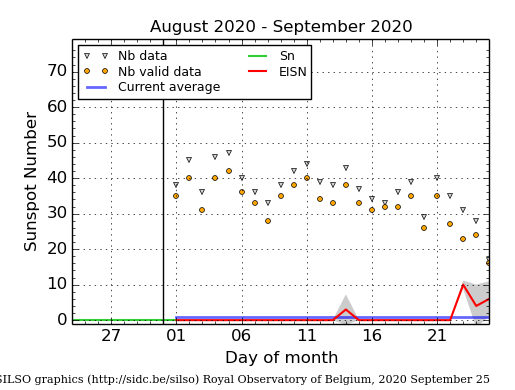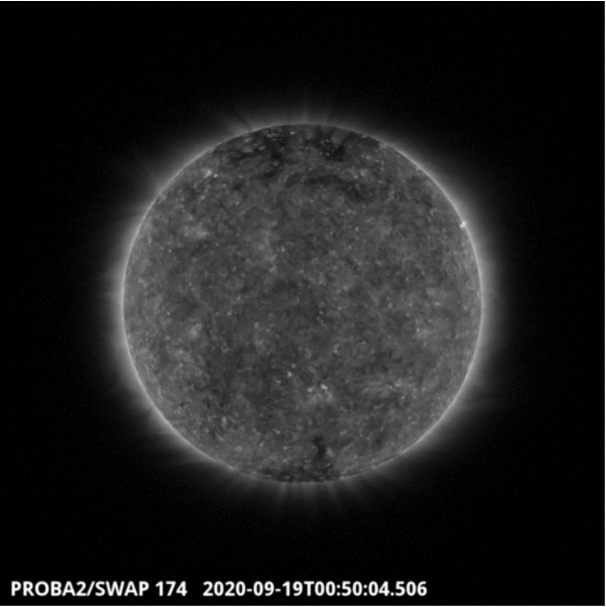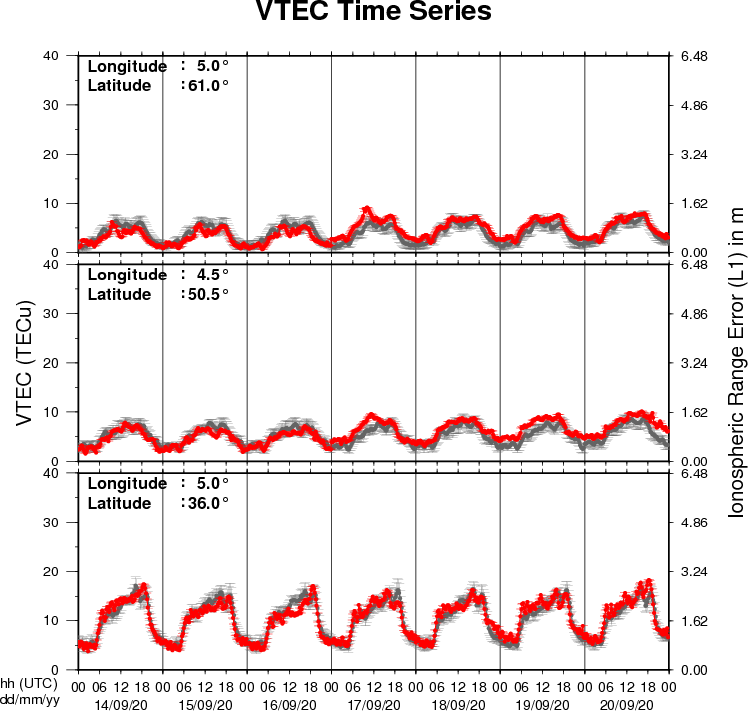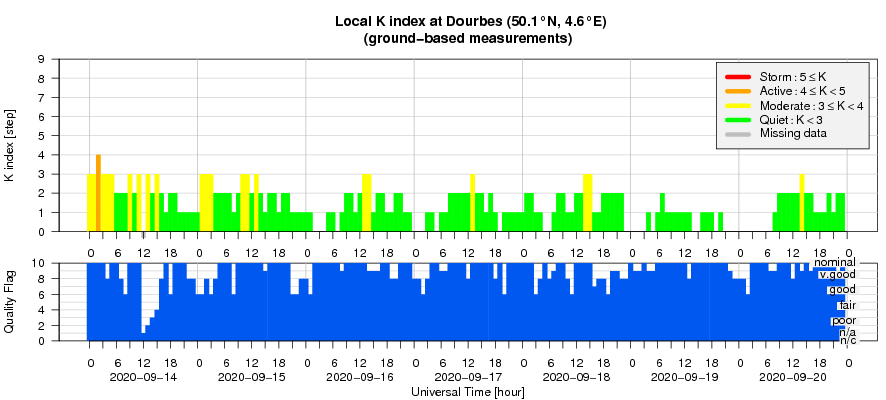- Table of Content
- 1.EUHFORIA - inn...
- 2.Review of sola...
- 3.The SIDC Space...
- 4.The Internatio...
- 5.PROBA2 Observa...
- 6.Geomagnetic Ob...
- 7.Review of iono...
2. Review of solar and geomagnetic activity
3. The SIDC Space Weather Briefing
4. The International Sunspot Number by Silso
5. PROBA2 Observations
6. Geomagnetic Observations at Dourbes
7. Review of ionospheric activity
EUHFORIA - innovative heliospheric modelling
EUHFORIA 2.0 is an extremely ambitious project to model the space around the sun and in which the earth floats. Camilla Scolini was there at the start of the project and brings us her story.

EUHFORIA 2.0 puts extra physics in the model imposed by plasma clouds and energetic particles thrown out by the sun and interacting with the Earth magnetic shield. The connection with the geospace, our space in which humans navigate and communicate is crucial to get our space weather forecast fine-tuned and as correct as possible.
Team work
At the kick-off in December 2019, the workflow was put in place. In the meanwhile, partners exchanged results and built a firm foundation for this heliospheric model with real data, real events and better science.
Camilla Scolini:”Coordination and team efforts are important in projects with this size. As deputy project manager it is nice to see such an enthusiasm amongst the team members. Our discussions at the kick-off in Leuven were for sure lively and animated.”
Camilla focused for her PhD which started in 2016, on Coronal Mass Ejections that had an impact on the geo-space. She worked with the former EUHFORIA. The 2.0 edition gave her the chance to rethink this and broaden the original study. The present work builds bridges between detail oriented experts, allowing to complete and deepen the sun-space-earth chain.

The picture above shows a 2D top (three full circles, (x,y)-HEEQ coordinates) and side (almost half circles, (z HEEQ,distance) view of the heliosphere. The white dot is the sun, the earth is the blue dot. From Camilla Scolini et al, 2020 ApJS 247 21
User test
EUHFORIA 2.0 will be tested in a real operational environment. The Regional Warning Centre of the STCE will run the model for the daily space weather forecast routine. This win-win situation allows on one hand the EUHFORIA 2.0 team to validate the complex model, on the other hand the forecast centre to use the newest techniques and models.
Looking forward
Camilla finished her PhD in May 2020. She stays in space weather research as she was awarded the prestigious Jack Eddy Postdoctoral Fellowship (2020-2022) by the NASA Living With a Star program, starting end of September 2020.
Stefaan Poedts, coordinator of EUHFORIA 2.0 and the whole team wishes Camilla all the best with her further career and hope to continue to collaborate in the future.
Check out: https://euhforia.com
Review of solar and geomagnetic activity
SOLAR ACTIVITY
The Sun was spotless. No flares were measured. The GOES X-ray flux background was around A0.5-A1 level.
There were no Earth-directed CMEs.
The greater than 10 MeV proton flux and the greater than 2 MeV electron flux were at nominal levels.
GEOMAGNETIC ACTIVITY
The solar wind as registered by DSCOVR was at nominal levels. The solar wind speed varied between about 270 and 435 km/s. The Interplanetary Magnetic Field alternated between away from the Sun and towards the Sun and had a magnitude between about 0 and 10 nT. Bz was below -5 nT for several intervals on September 14, with a lowest value slightly below -8 nT.
Although, both K Dourbes and NOAA Kp did not exceed 3.
The SIDC Space Weather Briefing
The Space Weather Briefing presented by the forecaster on duty from September 13 to 20. It reflects in images and graphs what is written in the Solar and Geomagnetic Activity report.

A pdf-version: http://www.stce.be/briefings/20200921_SWbriefing.pdf
The movie: http://www.stce.be/briefings/20200921_SWbriefing.m4v
The International Sunspot Number by Silso

The daily Estimated International Sunspot Number (EISN, red curve with shaded error) derived by a simplified method from real-time data from the worldwide SILSO network. It extends the official Sunspot Number from the full processing of the preceding month (green line). The plot shows the last 30 days (about one solar rotation). The horizontal blue line shows the current monthly average. The yellow dots gives the number of stations that provided valid data. Valid data are used to calculate the EISN. The triangle gives the number of stations providing data. When a triangle and a yellow dot coincide, it means that all the data is used to calculate the EISN of that day.
PROBA2 Observations
Solar Activity
Solar flare activity was very low during the week.
In order to view the activity of this week in more detail, we suggest to go to the following website from which all the daily (normal and difference) movies can be accessed: https://proba2.oma.be/ssa
This page also lists the recorded flaring events.
A weekly overview movie can be found here (SWAP week 547). http://proba2.oma.be/swap/data/mpg/movies/weekly_movies/weekly_movie_2020_09_14.mp4
Details about some of this week's events can be found further below.
If any of the linked movies are unavailable they can be found in the P2SC movie repository here https://proba2.oma.be/swap/data/mpg/movies/
Saturday Sep 19

A southern coronal hole had transited the central meridian around 00:50 UT - SWAP image
Find a movie of the events here (SWAP movie): http://proba2.oma.be/swap/data/mpg/movies/20200919_swap_movie.mp4
Review of ionospheric activity

The figure shows the time evolution of the Vertical Total Electron Content (VTEC) (in red) during the last week at three locations:
a) in the northern part of Europe(N61°, 5°E)
b) above Brussels(N50.5°, 4.5°E)
c) in the southern part of Europe(N36°, 5°E)
This figure also shows (in grey) the normal ionospheric behaviour expected based on the median VTEC from the 15 previous days.
The VTEC is expressed in TECu (with TECu=10^16 electrons per square meter) and is directly related to the signal propagation delay due to the ionosphere (in figure: delay on GPS L1 frequency).
The Sun's radiation ionizes the Earth's upper atmosphere, the ionosphere, located from about 60km to 1000km above the Earth's surface.The ionization process in the ionosphere produces ions and free electrons. These electrons perturb the propagation of the GNSS (Global Navigation Satellite System) signals by inducing a so-called ionospheric delay.
See http://stce.be/newsletter/GNSS_final.pdf for some more explanations ; for detailed information, see http://gnss.be/ionosphere_tutorial.php
